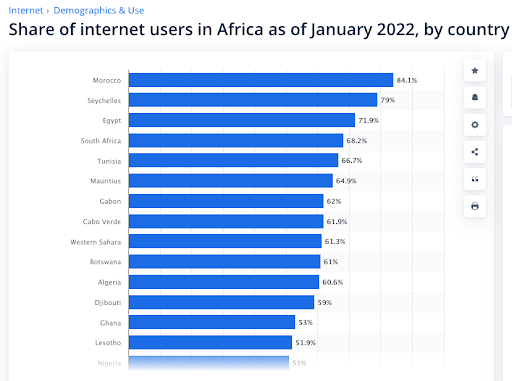With Europe set for steady growth, the Middle East’s digital expansion and a record number of new start-ups in Nigeria and across Africa, it’s a good idea to start focusing on EMEA marketing if you haven’t yet.
Marketing in the EMEA region requires tapping into local languages, cultures, working habits and customs, while also staying up to date on current events to ensure your content is relevant, respectful and timely for each market. This means using your local knowledge to show potential customers why they can trust you.
Throw in different logistics and legal requirements in each country, and the obstacles of EMEA marketing can quickly feel overwhelming. But it’s worth it. There are millions of potential customers awaiting you in these regions, you just need to know how to reach them.
What is EMEA marketing?

While the world is increasingly more globalized, content aimed at a North American audience isn’t going to resonate as strongly with clients in Europe, the Middle East and Africa. Local customs, religions, idioms, national holidays and even time zones get in the way of a “one-marketing-strategy-fits-all” approach.
EMEA marketing requires localizing and adapting your content to each region—including visuals, social media, video creation, SEO and keyword strategy, and even channels and platforms.
Get in touch with VeraContent if you’re looking for localized content in the EMEA regions, or download our free, interactive guide on adapting your content strategy to local markets below:

10 challenges facing content marketers in the EMEA region
Here are ten of the most common challenges EMEA marketers face in the region and how you can overcome them.
1. Many different languages are spoken in EMEA
With 24 official languages in the European Union, over 60 in the Middle East and an amazing 2,000 languages spoken in Africa—Nigeria alone has 522—it’s obvious from the outset that there will be some challenges with communicating with the vast audiences in the region.
You also need to bear in mind, for example, that German is spoken slightly differently in Germany from German spoken in Austria and Switzerland. Localized nuances make all the difference in how authentic your content sounds. Plus, keywords and other SEO strategies need to be adapted to your content’s language, requiring research and local knowledge.
In short: It’s important to have local writers and professionals on your team. Or reach out to an agency in the area who will help you convey your brand’s message flawlessly.
See also: Native language marketing: The benefits of local knowledge

2. Adapting to evolving economic and political factors
Unfortunately, war and conflict are heart-breakingly common in the EMEA regions. From the ongoing war in Yemen to the Russian attack on Ukraine and the Israeli–Palestinian conflict. There are also currently conflicts in Libya, South Sudan, the Central African Republic, Northern Mozambique, Ethiopia and Cameroon on the African continent.
The repercussions of these events are felt globally, and as a brand, it’s essential to factor in the many impacts they may have on your marketing strategy.
Adapting messaging and ways of working is fundamental in times of crisis. Sharing stories of hope is always uplifting, such as the survivor of the 1994 Rwandan genocide who has set up a FairTrade coffee company called Neza. Its profits go towards funding therapy for other genocide survivors.
See also: 5 global marketing strategies to inspire you in 2022
3. Variances in internet access and platform preference

In African countries, the increase in internet users in recent years is quite staggering. Brands need to adapt quickly to this and create enough content to satisfy demand.
There are, however, still variances in infrastructure across the EMEA regions.
While Europe and the Middle East have decent internet infrastructure, much of Africa depends on cell phone technology. Morocco has the most internet users, with over 80% of the population connected. Other nations such as Lesotho and Nigeria have half of their population connected, though mostly by cell phones rather than desktop computers.
When marketing in each EMEA region, it’s important to understand the digital connectivity the region has, including the devices and platforms your potential customers use. The best way to do this is to reach out to locals and do as much local market research as possible.
See also: How to build successful relationships with local community managers

4. Massive cultural differences across the regions
Simply translating copy into the local language might seem like an obvious solution to target new markets. However, not all content is suitable or relevant for each region or country. There are significant cultural differences across African, European and Middle Eastern cultures and among the countries in each area.
Having a local team who not only “gets” your brand but also speaks the language and understands the cultural nuances of the area is essential for success in the region.
The countries also all celebrate different holidays—from national days to religious and cultural celebrations. However, this can also be seen as an opportunity to create localized content for each audience. For example, see the post below that we did for St. Dalfour to celebrate United Arab Emirates National Day on their UAE Instagram account.

See also: Cultural marketing: Going beyond simple translations
Pro tip: Use Google Analytics to see what customers have been searching around your company or product to leverage that information as a graphic on social media or video.
5. Keeping up with evolving trends in each region is tricky
Trends are constantly changing and could be completely different in the EMEA countries than in your home market.
A great example to illustrate this is Bitdefender—a Romanian antivirus software company. Their YouTube channel contains support tutorials in French, German, English and other languages, while their social media platforms are kept up-to-date with the latest warnings on phishing scams and identity theft in different regions. By creating industry-focused content about security risks and other relevant topics, the YouTube channel has become a source of valuable content.

As always, if you pinpoint your clients’ interests and create relevant content for them, you’ll be on your way to success.
To avoid missing new trends or creating content that doesn’t resonate, it’s always best to work with a local EMEA marketing agency or with people who know the region really well.
6. Logistical challenges in the EMEA region
Every county has its own way of doing things. For example, marketing and delivering services in Switzerland will differ greatly from those in South Africa. In-depth knowledge of each country is crucial to reflect these logistical differences—from navigating the added cost and headaches of paperwork caused by the UK’s decision to leave the EU to the different VAT rules within African countries.
Your marketing EMEA strategy needs to consider each nation’s different rules to inform your local customers—and not cause unnecessary confusion!
7. Customers have different needs and problems in each region
Customer issues and problems in Europe, the Middle East and Africa may be completely different within each region—making customer and market research crucial. For example, a product or service needed in the EU may have no relevance in South Africa. And vice versa.
Having someone on the ground in each country who really understands the market needs could make or break your EMEA digital marketing campaigns.
“Content is key. Define your potential customers’ pains and draw their attention to how you can solve their problems.”
– Jérôme Logie, global marketing manager, NSF
8. Understanding customer behavior differences

It’s hard to generalize customer behaviors within one country, let alone across the entire EMEA region.
For example, studies in the Middle East have shown that customers aren’t as loyal to brands as they used to be and are also more health conscious. Meanwhile, across much of Africa, consumers seem to be more loyal to brands, and are open to paying more for quality.
It’s crucial to study your market of choice and adapt your marketing message accordingly. As concerns about the climate crisis grow globally, focusing on your company’s sustainability and environmental concerns is always likely to draw attention.
See also: International audience research methods: How to reach new markets effectively
9. Need to adhere to specific EMEA rules & regulations
General Data Protection Regulations (GDPR) in the EU and the Protection of Personal Information Act (POPI Act) in South Africa mean that you can’t collect people’s data without permission. So, for example, your website needs an “allow cookies” pop-up, and people have to opt in to receive newsletters and other communications. Using social media to engage with your audience is a way of getting around this—as is encouraging customers to sign up for your newsletter.
In the Middle East and Africa, respecting the Muslim religion is often crucial. For example, mentioning alcohol and ham products could be an issue. Just take the alcohol sales and advertising restrictions at the FIFA World Cup in Qatar, for example.
Freedom of expression laws are strict in North Africa and the Middle East too—with websites that criticize government policy often getting blocked. So remember to consider this when curating content.
A local team will consider local laws, such as GDPR in the EU, POPIA in South Africa and other local regulations.
10. Market research challenges
While over 40% of market research is conducted digitally around most of the world, that percentage is only 5% in South Africa and 13% in other African countries. Gaining insights into your customers’ needs and habits in the EMEA regions could be challenging.
Even though there will be more access to customer data in Europe and the Middle East, it’s still a good idea to contact a local agency to help sift through all the data and get a clear vision of formulating a marketing plan.
Work with locals on the ground
Setting up an EMEA digital marketing strategy needs some serious planning. With plenty of research and with the help of a dedicated EMEA marketing manager or global marketing agency, there’s no reason you can’t crack these markets as successfully as your home region.
At VeraContent, we have vast experience and fantastic teams in all regions to help you with EMEA marketing. Get in touch with us to learn more and find out if you qualify for a Free Content Consultation.

